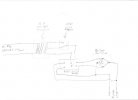- Joined
- Dec 5, 2009
- Messages
- 1,528
Whenever we have a defective battery charger or jump pack, we have to disassemble it. This transformer was inside the case and I'm curious if it would be suitable for my DIY etcher.
Here are the specs:
Class 2 Transformer
Model: YH-U41156600A
Pri. 120V 60Hz 15VA
Sec. 15.6AC 600mA
I assume the "Pri." is input voltage and the "Sec." is output?
Will this little transformer put out enough juice for the AC marking side of a DIY etcher?
Thanks!
Here are the specs:
Class 2 Transformer
Model: YH-U41156600A
Pri. 120V 60Hz 15VA
Sec. 15.6AC 600mA
I assume the "Pri." is input voltage and the "Sec." is output?
Will this little transformer put out enough juice for the AC marking side of a DIY etcher?
Thanks!

